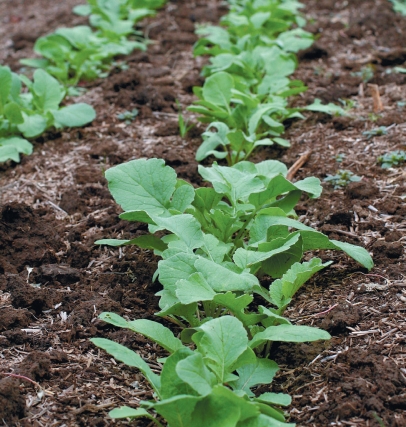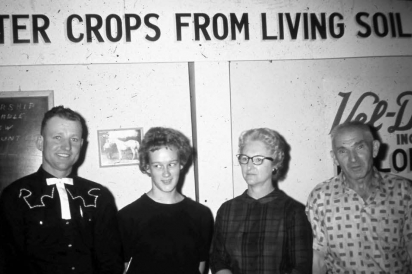Soil, Not Dirt: Grandpa Was a Nut Job or Why Dirt Was a Dirty Word
I didn’t know that I could launch my grandmother into orbit with just one word. I didn’t know that I was about to push the button that would unleash a tongue lashing so laden with finger pointing zeal that it would change me for life. But, I did. I misused a word. It was a disgrace. It was irreverent. It sort of just slipped out innocently. But, it provided the quintessential teachable moment, and my Grandma Stubbs pounced on it.
Like I said, I sent her into orbit. I’m not absolutely certain about many things in life, but I know with absolute certainty that I have NEVER used that word carelessly since that day. In fact, not only do I not misuse the word, when I hear it misused, it is as if my grandmother has been roused from her pastoral resting place in the Sharon Hill Cemetery to manifest herself in my body.
“It is not DIRT! It is SOIL! LIVING soil!” There are about three additional pages to the original diatribe, with references to humus (not hummus the Mediterranean dip, but humus, the deteriorated organic matter where the magic happens), worms, trace minerals, no till farming, the Circle of Life, waterways, sick cows, weakened immune systems, and something about an accident in Kansas that left a grain of wheat buried in my grandmother’s scalp.
What I didn’t realize is that referring to soil as dirt was worse than any profanity I could have uttered. Soil was sacred to my grandparents.
In the mid part of the 1900’s my grandfather was making a living testing dairy cows. He traveled all over eastern Iowa checking Holsteins from teeth to teats. What he saw compelled him to launch a business that defined my family for fifty years. It was sick dairy herds. He never saw so many sick animals. What had changed? Antibiotics started being given to all animals pre-emptively. And, as a result, sickness rose to levels never before witnessed.
I’m sure my grandfather’s grand ideas had been germinating for some time in his mind. But, it was this new practice of over using antibiotics that drove him to develop a lecture about the Circle of Life. (Yes, I know. You’re cursing me for the Lion King sound track now playing in your head, but that is what he called it.)
My grandfather began to seek out others who were concerned about the developments in the farming business. His quest led him to Dr. William Albrecht, Chairman of the Department of Soils at the University of Missouri. It was Dr. Albrecht who first championed the notion that the health of humans and animals was directly related to the health of the soil.
“If your soil is not healthy,” my grandfather would say, “it is doing nothing but holding up the plant. If the soil is not healthy, there is no way for the plant to be healthy.” I remember his hand drawn poster showing the diagram of the Circle of Life. I remember his corn stalks – healthy ones with huge root balls and puny, sick little plants with underdeveloped root systems – and ears of dried field corn – big, fat, kernels, row upon row, nearly twice the size of those grown the “new” way.
Unlike Fred Phelps, my grandfather’s following extended beyond his immediate family. He held lectures all over eastern Iowa speaking against the new agricultural practices taking hold across the Midwest. As many farmers began using anhydrous ammonia to increase production, my grandpa pleaded for people to understand that we were poisoning ourselves. What we put in the soil ended up in the crops that we fed to our livestock; when we consumed vegetation, meat, dairy, and eggs, we were consuming the chemicals we put into sacred soil. Not only that, but the chemicals were leaching into our water systems. Everything was being polluted in the name of increased efficiency on the farm and higher profit margins. Some people, primarily Amish, Mennonites, and hippies, began to listen. But, most thought my grandpa was a nut job.
So, my grandfather spent a semester with Dr. Albrecht and developed a line of natural feeds and fertilizers that would create healthy animals, healthy crops, and, most important of all, healthy soils. Next, my grandmother made the weekly 450-mile commute to Columbia to study soil testing. And, after a semester of tutelage, Dr. Albrecht’s staff came to Kalona, Iowa to set up a soil-testing lab for my grandmother.
When Rachel Carson’s seminal work, Silent Spring, was published in 1962, the environmental movement gained some traction with the general population, and my grandfather applied his agricultural knowledge to a more domesticated concern – lawns and gardens. He developed special blends of non-toxic fertilizers full of trace minerals that could restore health to depleted soils. I was always proud of the fact that the University of Iowa used my grandfather’s fertilizer on their golf course and the leading local lawn care company was a loyal customer for decades.
“Better Crops From Living Soil,” was the slogan of my grandparents’ business. And as you plan for spring, know that regardless of what you are growing this year it will be better in every way if you take steps to improve the health of your soil.
The first step in the journey is soil testing. No, my grandmother is no longer in the back room of the office putting test tubes on the shaker and working her way through dozens of coffee cans of soil samples. But, your local extension office will test your soil for not a lot of money. Dr. Albrecht, Rachel Carson, and my grandparents will be proud. Just please don’t call it dirt.
You can get your soil tested locally at the K-State and Missouri extension offices. Find instructions on their websites or call 913-715-7000 for the K-State office located in Olathe or 816-252-5051 for the MU Kansas City office.






